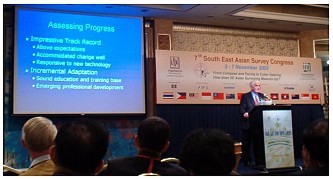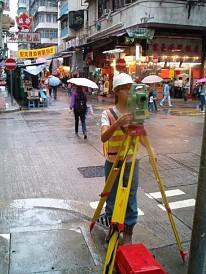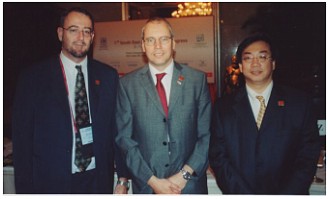7th South East
Asian Survey Congress in Hong Kong, SAR China, November 3-6, 2003
The 7th South East Asian Survey Congress (SEASC) took place in Hong Kong
November 3-6, 2003. SEASC occurs every four years and this time it involved
over 250 delegates from 25 countries. FIG was represented by the Council
(Vice Presidents Andreas Drees and TN Wong) and by the
Commission chairs Adam Greenland, Matt Higgins and Stephen
Yip).
 In
the program there were plenary sessions each morning with papers on many
“big picture” issues for the region. All technical papers are available on
the conference web site: http://www.seasc2003hk.org. In
the program there were plenary sessions each morning with papers on many
“big picture” issues for the region. All technical papers are available on
the conference web site: http://www.seasc2003hk.org.
Andreas Drees (FIG Deputy President from Germany) gave a keynote address
on “Shaping the Change – FIG Policy for the Challenges of Today’s World”.
He outlined the importance of the United Nations Millennium Declaration with
examples of issues where surveyors can contribute. He outlined FIG
contributions to such issues. Andreas also spoke of how surveyors have an
outer responsibility to society in general along with an inner
responsibility to profession itself. Many of the associations involved in
the SEASC are also member associations of FIG. He also pointed out that FIG
has 9 academic members in SE Asia. He indicated that FIG intends to continue
to strengthen its relationship with UN bodies and to also strengthen its
information policy (public relations). He also outlined FIG’s new initiative
of holding regional conferences in association relevant UN bodies and
mentioned Morocco (December 2003) and Jakarta (October 2004).
Shih Wing Ching (Chairman of Centaline Group) spoke on “Business
Opportunities in Mainland China for Surveying Professionals”. It should
be noted that the term “surveying” in Hong Kong is as broad as it is in the
UK. It includes real estate, property development, valuations, quantity
surveying etc. The Centaline Group decided to expand from its Hong Kong base
into Mainland China in 1992. Today, Centaline has become one of the biggest
property developers in Mainland China. This presentation outlined the
current boom economic conditions in China, the opportunities for foreign
professionals and the approach to conducting and building business there.
Bill Robertson (Past Surveyor General of New Zealand) gave a
plenary keynote entitled “Surveying! Preparing for Change and
Opportunities Into The Future”. One point that struck a chord was the
need to realise that when you get to a fully digital environment you need to
transform how you do things. He pointed out that studies are now showing
that incremental change will no longer deliver sufficient innovation and
growth, the curve is too flat. The evidence is that a sea change is needed
to get new growth in a digital world.
Earl James (Past President of FIG based in Darwin, Australia) gave
a plenary keynote on “A Review of the SEASC 1979-2003”. He outlined
his belief that there could be better participation by grass root surveyors.
He summarised his views by outlining what he believed were two shortcomings
of the Congresses to date:
- Not doing enough to involve the less developed countries of the
region.
- Not acting on resolutions and taking those resolutions to relevant
government organisations such as ASEAN.
Prof Yang Kai gave a keynote on “The Strategy and Policies for
Development of Geo-spatial Information Infrastructure (GSII) in China”.
He is President of the Chinese Society of Geodesy, Photogrammetry and
Cartography and former Deputy Director General of the State Bureau of
Surveying and Mapping (SBSM) for the PRC. He spoke about Al Gore’s
concept of Digital Earth and how they are applying that to strategies for a
Digital China, for Digital Provinces and for Digital Cities such as “Digital
Beijing”. He outlined the GSII (equivalent of our term SDI) for China
including its four parts and seven fundamental datasets. His excellent
PowerPoint presentation included several slides with graphics neatly
depicting different aspects of the GSII for China. Prof Yang Kai also spoke
of “3S integration” which is the integration of Remote Sensing (RS) plus GPS
and GIS. The end of his presentation included many fly-through depictions as
examples of how GSII is being applied to planning and decision-making in
China.
Dr. Khoo Boo Khean (President of the ASEAN Federation of Land
Surveying and Geomatics – ASEAN FLAG) gave a plenary keynote entitled “Pacing
The Times”. The paper examined the changing marketplace and preferences
of consumers, the role of technology and progression toward a knowledge
economy. He then outlined the role of Surveyors in that context and the need
to constantly work to maintain relevance to society. His presentation
finished with some observations on the work of ASEAN FLAG and its role in
the larger Asia-Pacific region and on the international stage.
General Technical Sessions
 |
After the plenary sessions each morning, the day was split into 2
parallel sessions. In the proceedings the papers are grouped in the
following categories:
- Cadastral Surveying
- Satellite Positioning and Geodetic Surveying
- Engineering Surveying
- Hydrographic Surveying
- Photogrammetric Surveying and Remote Sensing
- GIS and Spatial Information Management
- Valuation and Land Management
- Project, Cost and Contract Management
- Survey Instruments
- History of Surveying
FIG Commission 5 on Positioning and Measurement sponsored two of the
technical sessions. Esmond Mok (Hong Kong National Delegate to
Commission 5) chaired one session and Matt Higgins chaired the other.
|
Future SE Asian Survey Congresses
The SEASC in 2005 will be held in Brunei Darussalam and the 2007 SEASC
will be held in New Zealand. This is a good result for FIG in that the FIG
Working Week in 2007 will be in Hong Kong and the SEASC being in New Zealand
minimises the possibility of splitting the conference audiences in the
region.
FIG Meetings
 |
Matt Higgins, Adam Greenland and Stephen Yip at the
SEASC in Hong Kong. |
Present in Hong Kong were Deputy President of FIG, Andreas Drees
(Germany), FIG Vice President TN Wong (Hong Kong) and three FIG Commission
Chairs: Adam Greenland (from UK - Com 4 – Hydrographic), Stephen Yip (from
Hong Kong - Com 9 - Valuation and the Management of Real Estate) and Matt
Higgins (Com 5 - Positioning and Measurement). Rob Sarib (Vice Chair
of Administration of Comm. 5) was also present. The presence of 6 FIG
Officers enabled FIG to have 2 meetings to discuss various aspects of FIG
business. A major focus was a discussion paper seeking to have all
Commissions contribute to a FIG Good Practice Report (GPR). The GPR will be
published at the next 4-yearly FIG Congress in Munich in 2006, which is the
culmination of the term and work cycle for the current Commission Chairs.
Other issues included an analysis of the issues raised in the open forum and
the need for a mechanism at Working Weeks to allow Commissions to liaise
better and more directly with Member Associations.
During the SEASC we also convened an open forum on FIG matters, which was
attended by delegates from 10 countries. Vice President TN Wong convened the
forum. Adam Greenland and Matt Higgins outlined the FIG in general and the
work of the Commissions, including details on particular Commissions. Issues
discussed in the panel discussion included participation by national
delegates in the work of FIG Commissions, how to increase involvement in FIG
by less developed countries, and liaison with FIG international sister
associations.
Matt Higgins
Chair of FIG Commission 5 |























 In
the program there were plenary sessions each morning with papers on many
“big picture” issues for the region. All technical papers are available on
the conference web site:
In
the program there were plenary sessions each morning with papers on many
“big picture” issues for the region. All technical papers are available on
the conference web site: 
